Dysphagia Diet Thickening Agent Market
Dysphagia Diet Thickening Agent Market Size and Share Forecast Outlook 2025 to 2035
The dysphagia diet thickening agent market is projected to grow from USD 480.0 million in 2025 to USD 710.5 million by 2035, at a CAGR of 4.0%. Starch-based will dominate with a 55.0% market share, while hospitals will lead the end-user segment with a 40.0% share.
Dysphagia Diet Thickening Agent Market Forecast and Outlook 2025 to 2035
The dysphagia diet thickening agent market stands at the forefront of specialized nutritional care, positioned for steady expansion throughout the next decade as healthcare providers increasingly recognize the importance of texture modification in managing swallowing disorders.
The market's growth trajectory from USD 480.0 million in 2025 to USD 710.0 million by 2035 represents substantial development, the market will rise at a CAGR of 4.0% which demonstrating the growing adoption of therapeutic thickening solutions and specialized dietary management across healthcare facilities, home care environments, and long-term care institutions worldwide.
The first half of the forecast period (2025-2030) will witness the market climbing from USD 480.0 million to approximately USD 600.0 million, adding USD 120.0 million in value, which constitutes 52% of the total decade growth. This phase will be characterized by expanding awareness of dysphagia management protocols, driven by aging population demographics and increased recognition of swallowing disorder treatment across healthcare settings. Enhanced product formulations and improved palatability will become standard expectations rather than premium features.
The latter half (2030-2035) will continue measured expansion from USD 600.0 million to USD 710.0 million, representing an additional USD 110.0 million or 48% of the decade's growth. This period will be defined by widespread integration of thickening agents into routine care protocols, enhanced product standardization, and improved compatibility with existing dietary management systems. The market trajectory signals fundamental shifts in how healthcare providers approach dysphagia treatment and patient safety, with stakeholders positioned to benefit from growing demand across multiple product types and care settings.
Quick Stats for Dysphagia Diet Thickening Agent Market
- Dysphagia Diet Thickening Agent Market Value (2025): USD 480.0 million
- Dysphagia Diet Thickening Agent Market Forecast Value (2035): USD 710.0 million
- Dysphagia Diet Thickening Agent Market Forecast CAGR: 4.0%
- Leading Product Type in Dysphagia Diet Thickening Agent Market: Starch-based Thickeners
- Key Growth Regions in Dysphagia Diet Thickening Agent Market: North America, Europe, and Asia Pacific
- Top Players in Dysphagia Diet Thickening Agent Market: Nestlé Health Science, Danone Nutricia, Fresenius Kabi, Abbott Nutrition, Hormel Health Labs
- Where revenue comes from - Now Vs Next (Industry-level view)
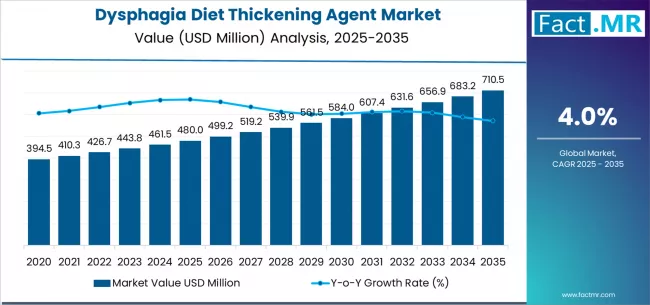
| Period | Primary Revenue Buckets | Share | Notes |
|---|---|---|---|
| Today | Hospital dietary services | 40% | Institution-driven, safety protocols |
| Home care consumption | 35% | Family-managed, convenience focus | |
| Long-term care facilities | 25% | Professional oversight, bulk purchasing | |
| Future (3-5 yrs) | Hospital integration systems | 35-38% | Automated dispensing, protocol adherence |
| Home care solutions | 38-42% | User-friendly packaging, education support | |
| LTC facility programs | 20-22% | Standardized protocols, staff training | |
| Specialty care channels | 3-5% | Rehabilitation centers, outpatient clinics |
Dysphagia Diet Thickening Agent Market Key Takeaways
At-a-Glance Metrics
| Metric | Value |
|---|---|
| Market Value (2025) → | USD 480.0 million |
| Market Forecast (2035) ↑ | USD 710.0 million |
| Growth Rate ★ | 4.0% CAGR |
| Leading Product → | Starch-based Thickeners |
| Primary End User → | Hospitals |
The market demonstrates stable fundamentals with starch-based thickening agents capturing dominant share through proven effectiveness and widespread clinical acceptance for dysphagia management. Hospital applications drive primary demand, supported by established protocols and professional oversight requirements. Geographic expansion remains concentrated in developed markets with aging populations, while emerging economies show growing adoption rates driven by healthcare infrastructure development and increased awareness of swallowing disorder management.
Imperatives for Stakeholders in Dysphagia Diet Thickening Agent Market
Prioritize safety and consistency
- Offer comprehensive safety packages: product + clinical guidelines + staff training + safety protocols + outcome monitoring.
- Develop standardized procedures: preparation guidelines, consistency testing, quality assurance, and documentation systems for clinical compliance.
Educational support integration
- Clinical training programs, caregiver education resources, and professional development opportunities (protocol implementation, safety monitoring, patient assessment capabilities).
Quality assurance approach
- Consistent texture outcomes, standardized preparation methods, clinical effectiveness validation, and comprehensive safety documentation.
Care-focused pricing models
- Transparent institutional pricing + clear volume tiers (safety training, preparation support, clinical outcomes); educational programs for proper utilization.
Segmental Analysis
The market is segmented by product type into starch-based and gum-based thickening agents, representing the evolution from traditional thickening solutions to specialized formulations for comprehensive dysphagia management and patient safety optimization.
End-user segmentation divides the market into hospitals, homecare, and long-term care facilities, reflecting distinct requirements for clinical oversight, family management, and professional care standards across healthcare environments.
Geographic distribution covers North America, Europe, Asia Pacific, Latin America, and Middle East & Africa, with developed markets leading adoption while emerging economies show accelerating growth patterns driven by healthcare infrastructure expansion and aging population demographics.
The segmentation structure reveals treatment progression from basic texture modification toward comprehensive dietary management systems with enhanced safety and patient acceptance capabilities, while end-user diversity spans from hospital clinical settings to home care environments requiring reliable consistency and ease of preparation.
By Product Type, the Starch-based Segment Accounts for Dominant Market Share
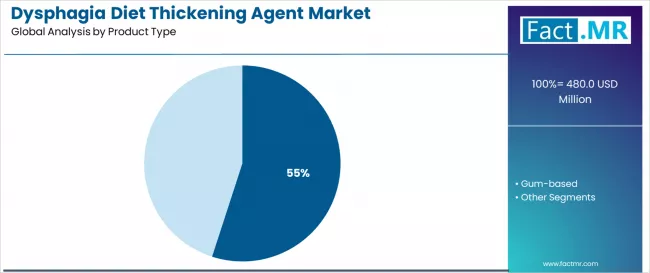
Starch-based thickening agents command the leading position in the dysphagia diet thickening agent market with 55% market share through proven clinical effectiveness, widespread acceptance, and reliable consistency performance that enables healthcare providers to achieve predictable texture modification across diverse patient populations and care environments.
The segment benefits from healthcare provider preference for familiar thickening solutions that provide consistent texture outcomes, straightforward preparation protocols, and established safety profiles without requiring significant training modifications. Advanced formulation features enable improved palatability, enhanced stability, and compatibility with various liquid types, where clinical reliability and patient acceptance represent critical care requirements.
Starch-based products differentiate through proven clinical performance, cost-effectiveness, and integration with existing dietary protocols that enhance patient safety while maintaining optimal nutrition delivery across various dysphagia severity levels and patient demographics.
Key market characteristics:
- Proven formulation designs with optimized thickening properties and consistent texture development
- Established clinical effectiveness, enabling reliable outcomes with high healthcare provider confidence
- Healthcare compatibility, including allergen considerations, preparation simplicity, and integration with comprehensive dysphagia management protocols
Gum-based Thickeners Show Specialized Growth
Gum-based thickening agents maintain a 45% market position in the dysphagia diet thickening agent market due to their advanced thickening properties and specialized applications for complex dysphagia cases.
These products appeal to healthcare providers requiring enhanced texture control and improved stability characteristics for challenging dietary management scenarios. Market growth is driven by clinical evidence supporting superior consistency and increasing recognition of advanced thickening technology benefits.
By End User, the Hospitals Segment Shows Market Leadership
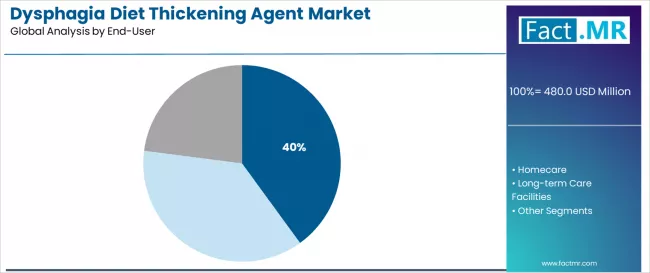
Hospitals demonstrate market leadership in the dysphagia diet thickening agent market with 40% share due to clinical oversight requirements and comprehensive safety protocols, emphasizing professional management of dysphagia patients, standardized preparation procedures, and integrated dietary services that maximize patient safety while maintaining treatment effectiveness standards.
Hospital operators prioritize product reliability, staff training support, and integration with existing dietary services that enable coordinated care delivery across multiple clinical departments. The segment benefits from established clinical protocols and comprehensive patient management programs that emphasize the importance of consistent texture modification for patient safety and nutritional adequacy applications.
Healthcare expansion programs incorporate dysphagia management as standard care protocol, while patient safety initiatives increase demand for reliable thickening solutions that comply with clinical standards and minimize aspiration risks.
Varying preparation protocols and staff training requirements may create complexity in product standardization across different hospital systems or clinical scenarios.
Application dynamics include:
- Strong growth in clinical protocol integration requiring comprehensive staff training and safety monitoring capabilities
- Increasing adoption in patient safety and nutritional care applications for diverse hospital populations
- Rising integration with dietary management systems for comprehensive care coordination and outcome tracking
Homecare Applications Show Growing Demand
Homecare applications capture 35% market share through family-managed care requirements in residential settings, rehabilitation support, and caregiver-administered applications. These environments demand user-friendly preparation systems capable of delivering consistent results while providing effective safety guidance and preparation simplicity.
Long-term Care Facilities Maintain Professional Oversight
Long-term care facilities account for 25% market share, including nursing homes, assisted living facilities, and specialized care centers requiring professional dietary management and bulk preparation capabilities for operational efficiency and consistent care delivery.
By Clinical Application, Safety-Focused Management Drives Demand
Clinical applications emphasize patient safety and aspiration prevention through standardized texture modification protocols, reflecting the primary focus on reducing swallowing-related complications and improving nutritional intake.
Clinical oversight provides validation for product selection, driving consistent utilization and compliance monitoring while maintaining quality assurance and therapeutic outcome tracking.
Professional applications include clinical assessment, preparation oversight, and outcome monitoring that drive consistent product demand while providing access to advanced thickening technologies.
What are the Drivers, Restraints, and Key Trends of the Dysphagia Diet Thickening Agent Market?
| Category | Factor | Impact | Why It Matters |
|---|---|---|---|
| Driver | Aging population & stroke incidence | ★★★★★ | Demographic trends increase dysphagia prevalence; growing patient population requires effective texture modification solutions with proven safety profiles across age groups. |
| Driver | Healthcare safety protocols & aspiration prevention | ★★★★★ | Enhanced safety awareness transforms dysphagia management from "optional" to "mandatory"; standardized protocols drive consistent market demand. |
| Driver | Home healthcare expansion & family caregiving | ★★★★☆ | Shift toward home-based care increases demand for user-friendly products; family caregiver needs drive simplified preparation and safety education requirements. |
| Restraint | Palatability challenges & patient acceptance | ★★★☆☆ | Texture modification affects food enjoyment; patient resistance limits compliance and creates barriers to consistent usage across treatment protocols. |
| Restraint | Preparation complexity & training requirements | ★★★☆☆ | Proper preparation demands specific techniques; inadequate training affects product effectiveness and limits adoption in less supervised environments. |
| Trend | Product innovation & palatability improvement | ★★★★☆ | Advanced formulations enhance patient acceptance; improved taste and texture properties drive competitive differentiation and market expansion. |
| Trend | Standardized care protocols & quality assurance | ★★★★☆ | Evidence-based guidelines establish consistent practices; protocol standardization drives product adoption and professional confidence in treatment outcomes. |
Analysis of the Dysphagia Diet Thickening Agent Market by Key Country
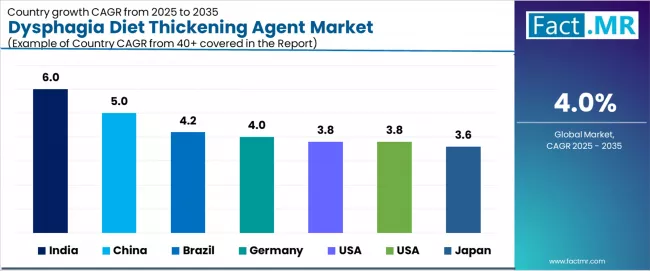
The dysphagia diet thickening agent market demonstrates varied regional dynamics with Growth Leaders including India (6.0% growth rate) and China (5.0% growth rate) driving expansion through healthcare infrastructure development and aging population management programs.
Steady performers encompass Brazil (4.2% growth rate), Germany (4.0% growth rate), and developed regions, benefiting from established healthcare systems and comprehensive dysphagia care protocols. Mature Markets feature United States (3.8% growth rate), South Korea (3.8% growth rate), and Japan (3.6% growth rate), where advanced healthcare infrastructure supports consistent growth through protocol optimization and care quality improvements.
Regional analysis reveals Asian markets leading adoption through demographic transitions and healthcare capacity building, while North American countries maintain steady expansion supported by clinical protocol advancement and comprehensive care integration. European markets show moderate growth driven by aging populations and advanced clinical care standards.
| Region/Country | 2025-2035 Growth | How to win | What to watch out |
|---|---|---|---|
| India | 6.0% | Focus on affordable accessibility | Healthcare infrastructure gaps |
| China | 5.0% | Lead with clinical education | Regulatory approval complexity |
| Brazil | 4.2% | Provide training support | Economic access barriers |
| Germany | 4.0% | Offer premium safety solutions | Over-regulation concerns |
| United States | 3.8% | Push protocol integration | Reimbursement limitations |
| South Korea | 3.8% | Emphasize quality outcomes | Aging care capacity |
| Japan | 3.6% | Focus on convenience solutions | Market saturation risks |
India Drives Fastest Market Growth
India establishes fastest market growth through comprehensive healthcare infrastructure development and rising awareness of dysphagia management, integrating thickening agents as essential components in geriatric care and stroke rehabilitation programs. The country's 6.0% growth rate reflects healthcare modernization initiatives and increasing clinical education programs that promote proper dysphagia management in healthcare facilities and home care environments. Growth concentrates in major healthcare centers, including Delhi, Mumbai, and Bangalore, where clinical advancement showcases integrated care systems that appeal to healthcare providers seeking effective patient safety solutions and family caregiver support applications.
Indian healthcare providers are developing accessible thickening solutions that combine affordability with clinical effectiveness, including simplified preparation methods and culturally appropriate educational materials. Distribution networks through healthcare facilities and pharmacy chains expand market access, while government healthcare initiatives support improved access to dysphagia management tools across diverse patient populations and geographic regions.
Strategic Market Indicators:
- Healthcare facilities leading adoption with expanding geriatric care services and stroke rehabilitation programs
- Government healthcare initiatives providing improved access to specialized nutritional care and patient safety protocols
- Local distributors capturing market share through competitive pricing and regional healthcare provider relationships
- Clinical education programs driving awareness and proper utilization across healthcare professional networks
China Emerges as High-Growth Market
In Beijing, Shanghai, and Guangzhou, healthcare facilities and long-term care institutions are implementing comprehensive dysphagia management programs as standard care protocols for elderly patients and stroke survivors, driven by demographic transitions and healthcare quality improvement initiatives that emphasize the importance of aspiration prevention. The market holds a 5.0% growth rate, supported by aging population trends and healthcare capacity expansion that promote advanced care solutions for diverse patient populations. Chinese healthcare providers are adopting thickening products that provide reliable safety outcomes and professional preparation protocols, particularly appealing in urban regions where healthcare quality standards and family care expectations represent significant considerations.
Market expansion benefits from growing clinical awareness and international healthcare partnerships that enable access to advanced dysphagia management solutions for various care settings. Healthcare adoption follows patterns established in specialized nutrition, where safety and effectiveness drive clinical decisions and patient care protocols.
Market Intelligence Brief:
- Healthcare and institutional segments driving adoption with growing emphasis on patient safety and clinical quality standards
- Healthcare modernization programs emphasizing geriatric care integration and comprehensive patient safety management
- International partnerships enabling advanced product availability and clinical training program development
- Healthcare education initiatives implementing awareness programs for proper dysphagia assessment and management
Brazil Shows Strong Regional Leadership
Brazil's market expansion benefits from diverse healthcare demand, including healthcare modernization in São Paulo and Rio de Janeiro, institutional care facility development, and healthcare education programs that increasingly incorporate dysphagia management solutions for patient safety applications. The country maintains a 4.2% growth rate, driven by healthcare infrastructure development and increasing recognition of texture modification benefits, including improved patient safety and enhanced nutritional care.
Market dynamics focus on practical thickening solutions that balance clinical effectiveness with preparation simplicity important to Brazilian healthcare providers and family caregivers. Growing healthcare awareness creates continued demand for accessible dysphagia management products in facility care and home healthcare applications.
Strategic Market Considerations:
- Healthcare and institutional segments leading growth with focus on patient safety and caregiver education
- Regional healthcare requirements driving diverse product approaches from basic thickening solutions to comprehensive care protocols
- Economic considerations balanced with healthcare quality improvements and patient safety priorities
- Healthcare education initiatives influencing adoption standards and clinical practice development
Germany Shows Clinical Leadership
Germany's advanced healthcare market demonstrates sophisticated dysphagia management deployment with documented clinical effectiveness in hospital applications and long-term care facilities through integration with existing clinical protocols and safety standards. The country leverages medical expertise in geriatric care and clinical nutrition integration to maintain a 4.0% growth rate. Healthcare centers across Bavaria, North Rhine-Westphalia, and Baden-Württemberg showcase premium care systems where thickening agents integrate with comprehensive patient care platforms and clinical management protocols to optimize safety outcomes and nutritional adequacy.
German healthcare providers prioritize product quality and EU compliance in dysphagia management solutions, creating demand for premium products with advanced safety features, including clinical validation and comprehensive preparation protocols. The market benefits from established healthcare infrastructure and investment in advanced clinical care that provides long-term patient benefits and compliance with international safety standards.
Market Intelligence Brief:
- Clinical focus on EU standardization and safety compliance, driving premium segment growth
- Healthcare partnerships providing accelerated clinical validation and care protocol optimization
- Technology collaboration between German providers and international nutrition companies
- Clinical education programs expanding dysphagia management knowledge in healthcare applications
United States Maintains Market Leadership
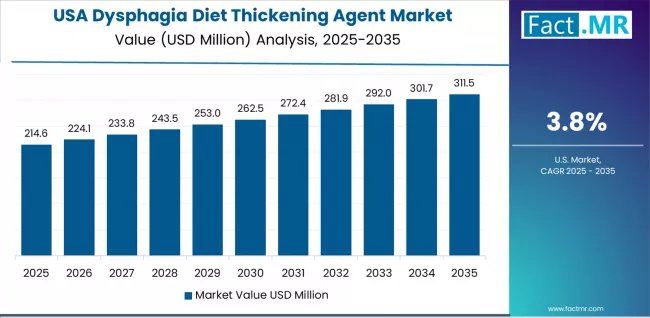
United States establishes market leadership through comprehensive healthcare programs and advanced clinical infrastructure development, integrating dysphagia thickening agents across hospital dietary services and home healthcare environments. The country's 3.8% growth rate reflects established clinical relationships and mature care adoption that supports widespread use of texture modification solutions in clinical and family care applications. Growth concentrates in major healthcare markets, including California, Texas, and New York, where healthcare innovation showcases advanced care deployment that appeals to healthcare providers seeking proven safety solutions and comprehensive caregiver support applications.
American healthcare providers leverage established distribution networks and comprehensive clinical capabilities, including specialized dietary services and home healthcare integration that create patient relationships and care advantages. The market benefits from mature clinical standards and healthcare coverage that support treatment access while encouraging product innovation and safety advancement.
Market Intelligence Brief:
- Healthcare and home care facilities maintaining high adoption rates with comprehensive safety protocols
- Established clinical standards providing consistent demand for innovation and safety advancement
- Healthcare coverage systems supporting access to specialized nutritional care and dysphagia management
- Clinical research programs expanding understanding of texture modification and patient safety outcomes
South Korea Demonstrates Care Innovation
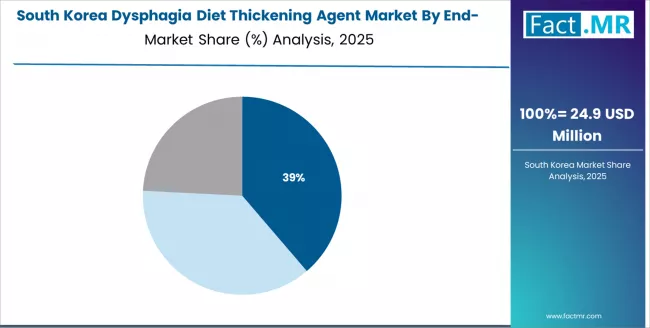
South Korea maintains steady market growth through advanced healthcare technology and comprehensive elderly care programs, embedding dysphagia thickening agents within integrated patient care systems and family healthcare applications. The country’s 3.8% growth rate reflects healthcare advancement and structured aging population management, supporting effective care delivery and caregiver education initiatives.
Market development emphasizes quality-enhanced thickening solutions designed for clinical reliability and family-friendly preparation, ensuring consistent patient outcomes while aligning with integrated care frameworks across hospitals, long-term care facilities, and home healthcare networks.
Market Intelligence Brief:
- Integrated elderly care programs driving steady adoption of dysphagia management solutions
- Focus on quality and reliability in thickening agents to support consistent patient outcomes
- Family caregiver education programs expanding awareness and proper usage in home settings
- Healthcare technology platforms embedding dysphagia care into broader patient management systems
Japan Shows Mature Market Development
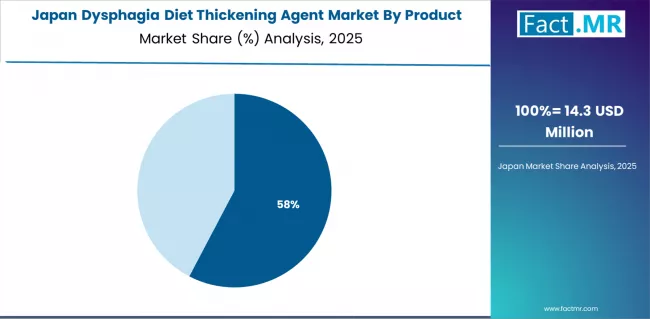
Japan’s established healthcare system demonstrates comprehensive dysphagia management integration, with hospitals, elderly care facilities, and home care services maintaining consistent adoption through proven clinical protocols and robust family care support systems. The country sustains a 3.6% growth rate, reflecting market maturity and ongoing healthcare optimization that ensures continued utilization of texture modification solutions across diverse care environments.
Market dynamics emphasize convenience and preparation simplicity, supporting effective care delivery in an aging society while enabling family caregivers to manage patient nutrition with consistency and safety.
Market Intelligence Brief:
- Mature adoption of dysphagia solutions underpinned by standardized clinical protocols
- Strong emphasis on convenience and preparation ease for caregivers in clinical and home environments
- Healthcare optimization ensures continuity of use across both institutional and family care settings
- Aging society driving sustained demand for effective, proven texture modification solutions
Europe Market Split by Country
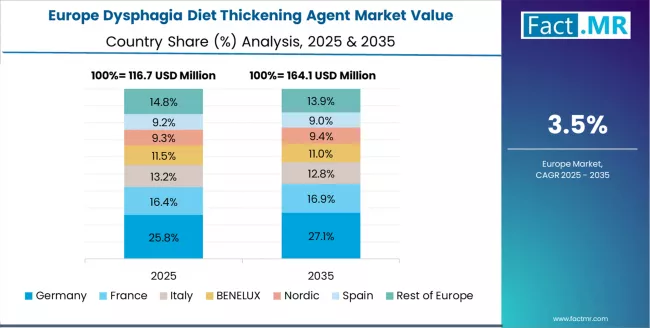
The European dysphagia diet thickening agent market is projected to grow from USD 410.0 million in 2025 to USD 580.0 million by 2035, registering a CAGR of 4.1% over the forecast period. Germany is expected to maintain its leadership position with a 20.7% market share in 2025, supported by advanced healthcare infrastructure and comprehensive geriatric care services.
France follows with a 17.1% share in 2025, driven by structured healthcare programs and clinical excellence initiatives. The United Kingdom holds a 15.9% share through specialized healthcare applications and community care programs. Italy commands a 13.4% share, while Spain accounts for 12.2% in 2025.
The Rest of Europe collectively represents a 20.7% share, reflecting growing healthcare awareness in Nordic countries and the emergence of dysphagia management program development across Eastern Europe. By 2035, the market distribution is expected to remain balanced as aging populations expand and dysphagia management awareness increases across regional healthcare systems.
Competitive Landscape of the Dysphagia Diet Thickening Agent Market
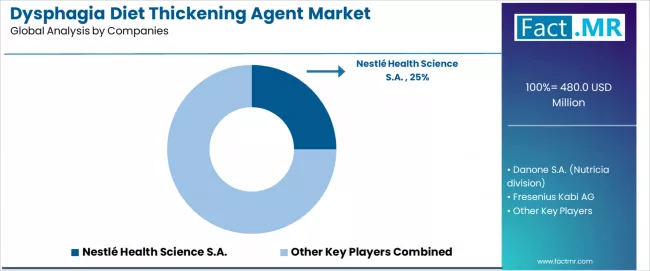
- Structure: Approximately 10-12 established players; top 5 hold roughly 65-70% by revenue.
- Leadership is maintained through: clinical validation, distribution networks, and product reliability (safety + consistency + ease of use).
- What's commoditizing: basic starch thickening formulations and standard preparation methods.
- Margin Opportunities: specialized formulations, clinical education programs, and integration into comprehensive care protocols.
| Stakeholder | What they actually control | Typical strengths | Typical blind spots |
|---|---|---|---|
| Global nutrition companies | R&D capabilities, regulatory expertise, distribution reach | Proven clinical evidence, comprehensive portfolios, established healthcare relationships | Innovation speed; specialized care responsiveness |
| Healthcare specialists | Clinical relationships, specialized expertise, care protocols | Deep clinical knowledge, safety focus, professional trust | Market reach limitations; cost competitiveness |
| Regional manufacturers | Local market knowledge, pricing flexibility, cultural adaptation | Market responsiveness, competitive pricing, local compliance | Technology gaps; clinical validation |
| Food technology companies | Product innovation, formulation expertise, manufacturing scale | Technical capabilities, cost efficiency, quality consistency | Clinical understanding; healthcare relationships |
Nestlé Health Science S.A.
- Danone S.A. (Nutricia division)
- Fresenius Kabi AG
- Abbott Laboratories (Abbott Nutrition division)
- Hormel Health Labs, Inc.
- SimplyThick LLC
- Kent Precision Foods Group Inc.
- Nutri Co. Ltd.
- Nualtra Limited
- Flavour Creations Pty Ltd.
- TastiPure, LLC
- Resource ThickenUp (Nestlé Health Science brand)
- Apetito AG
- Medline Industries, LP (Nutrition division)
- NutriThick LLC
Scope of the Report
| Items | Values |
|---|---|
| Quantitative Units (2025) | USD 480.0 million |
| Product Type | Starch-based, Gum-based |
| End User | Hospitals, Homecare, Long-term Care Facilities |
| Regions Covered | North America, Europe, Asia Pacific, Latin America, Middle East & Africa |
| Countries Covered | United States, China, Germany, India, United Kingdom, Japan, Canada, Brazil, France, South Korea, and 15+ additional countries |
| Key Companies Profiled | Nestlé Health Science, Danone Nutricia, Fresenius Kabi, Abbott Nutrition, Hormel Health Labs, SimplyThick, Kent Precision Foods, Nutri Co, Nualtra, Flavour Creations |
| Additional Attributes | Dollar sales by product type and end-user segments, regional adoption trends across North America, Europe, and Asia Pacific, competitive landscape with nutrition companies and healthcare providers, healthcare provider preferences for safety and consistency, integration with clinical protocols and dietary management systems, innovations in thickening formulations and preparation methods, and development of advanced texture modification solutions with enhanced patient safety and nutritional care capabilities. |
Dysphagia Diet Thickening Agent Market by Segments
-
Product Type :
- Starch-based
- Gum-based
-
End User :
- Hospitals
- Homecare
- Long-term Care Facilities
-
Region :
- North America
- United States
- Canada
- Mexico
- Europe
- Germany
- France
- United Kingdom
- Italy
- Spain
- Nordic
- BENELUX
- Rest of Europe
- Asia Pacific
- China
- Japan
- India
- South Korea
- Australia & New Zealand
- ASEAN
- Rest of Asia Pacific
- Latin America
- Brazil
- Argentina
- Rest of Latin America
- Middle East & Africa
- Kingdom of Saudi Arabia
- Other GCC Countries
- South Africa
- Turkey
- Rest of Middle East & Africa
- North America
Table of Content
- Executive Summary
- Global Market Outlook
- Demand to side Trends
- Supply to side Trends
- Technology Roadmap Analysis
- Analysis and Recommendations
- Market Overview
- Market Coverage / Taxonomy
- Market Definition / Scope / Limitations
- Market Background
- Market Dynamics
- Drivers
- Restraints
- Opportunity
- Trends
- Scenario Forecast
- Demand in Optimistic Scenario
- Demand in Likely Scenario
- Demand in Conservative Scenario
- Opportunity Map Analysis
- Product Life Cycle Analysis
- Supply Chain Analysis
- Investment Feasibility Matrix
- Value Chain Analysis
- PESTLE and Porter’s Analysis
- Regulatory Landscape
- Regional Parent Market Outlook
- Production and Consumption Statistics
- Import and Export Statistics
- Market Dynamics
- Global Market Analysis 2020 to 2024 and Forecast, 2025 to 2035
- Historical Market Size Value (USD Million) Analysis, 2020 to 2024
- Current and Future Market Size Value (USD Million) Projections, 2025 to 2035
- Y to o to Y Growth Trend Analysis
- Absolute $ Opportunity Analysis
- Global Market Pricing Analysis 2020 to 2024 and Forecast 2025 to 2035
- Global Market Analysis 2020 to 2024 and Forecast 2025 to 2035, By Product Type
- Introduction / Key Findings
- Historical Market Size Value (USD Million) Analysis By Product Type , 2020 to 2024
- Current and Future Market Size Value (USD Million) Analysis and Forecast By Product Type , 2025 to 2035
- Starch-based
- Gum-based
- Y to o to Y Growth Trend Analysis By Product Type , 2020 to 2024
- Absolute $ Opportunity Analysis By Product Type , 2025 to 2035
- Global Market Analysis 2020 to 2024 and Forecast 2025 to 2035, By End-User
- Introduction / Key Findings
- Historical Market Size Value (USD Million) Analysis By End-User, 2020 to 2024
- Current and Future Market Size Value (USD Million) Analysis and Forecast By End-User, 2025 to 2035
- Hospitals
- Homecare
- Long-term Care Facilities
- Y to o to Y Growth Trend Analysis By End-User, 2020 to 2024
- Absolute $ Opportunity Analysis By End-User, 2025 to 2035
- Global Market Analysis 2020 to 2024 and Forecast 2025 to 2035, By Region
- Introduction
- Historical Market Size Value (USD Million) Analysis By Region, 2020 to 2024
- Current Market Size Value (USD Million) Analysis and Forecast By Region, 2025 to 2035
- North America
- Latin America
- Western Europe
- Eastern Europe
- East Asia
- South Asia and Pacific
- Middle East & Africa
- Market Attractiveness Analysis By Region
- North America Market Analysis 2020 to 2024 and Forecast 2025 to 2035, By Country
- Historical Market Size Value (USD Million) Trend Analysis By Market Taxonomy, 2020 to 2024
- Market Size Value (USD Million) Forecast By Market Taxonomy, 2025 to 2035
- By Country
- USA
- Canada
- Mexico
- By Product Type
- By End-User
- By Country
- Market Attractiveness Analysis
- By Country
- By Product Type
- By End-User
- Key Takeaways
- Latin America Market Analysis 2020 to 2024 and Forecast 2025 to 2035, By Country
- Historical Market Size Value (USD Million) Trend Analysis By Market Taxonomy, 2020 to 2024
- Market Size Value (USD Million) Forecast By Market Taxonomy, 2025 to 2035
- By Country
- Brazil
- Chile
- Rest of Latin America
- By Product Type
- By End-User
- By Country
- Market Attractiveness Analysis
- By Country
- By Product Type
- By End-User
- Key Takeaways
- Western Europe Market Analysis 2020 to 2024 and Forecast 2025 to 2035, By Country
- Historical Market Size Value (USD Million) Trend Analysis By Market Taxonomy, 2020 to 2024
- Market Size Value (USD Million) Forecast By Market Taxonomy, 2025 to 2035
- By Country
- Germany
- UK
- Italy
- Spain
- France
- Nordic
- BENELUX
- Rest of Western Europe
- By Product Type
- By End-User
- By Country
- Market Attractiveness Analysis
- By Country
- By Product Type
- By End-User
- Key Takeaways
- Eastern Europe Market Analysis 2020 to 2024 and Forecast 2025 to 2035, By Country
- Historical Market Size Value (USD Million) Trend Analysis By Market Taxonomy, 2020 to 2024
- Market Size Value (USD Million) Forecast By Market Taxonomy, 2025 to 2035
- By Country
- Russia
- Poland
- Hungary
- Balkan & Baltic
- Rest of Eastern Europe
- By Product Type
- By End-User
- By Country
- Market Attractiveness Analysis
- By Country
- By Product Type
- By End-User
- Key Takeaways
- East Asia Market Analysis 2020 to 2024 and Forecast 2025 to 2035, By Country
- Historical Market Size Value (USD Million) Trend Analysis By Market Taxonomy, 2020 to 2024
- Market Size Value (USD Million) Forecast By Market Taxonomy, 2025 to 2035
- By Country
- China
- Japan
- South Korea
- By Product Type
- By End-User
- By Country
- Market Attractiveness Analysis
- By Country
- By Product Type
- By End-User
- Key Takeaways
- South Asia and Pacific Market Analysis 2020 to 2024 and Forecast 2025 to 2035, By Country
- Historical Market Size Value (USD Million) Trend Analysis By Market Taxonomy, 2020 to 2024
- Market Size Value (USD Million) Forecast By Market Taxonomy, 2025 to 2035
- By Country
- India
- ASEAN
- Australia & New Zealand
- Rest of South Asia and Pacific
- By Product Type
- By End-User
- By Country
- Market Attractiveness Analysis
- By Country
- By Product Type
- By End-User
- Key Takeaways
- Middle East & Africa Market Analysis 2020 to 2024 and Forecast 2025 to 2035, By Country
- Historical Market Size Value (USD Million) Trend Analysis By Market Taxonomy, 2020 to 2024
- Market Size Value (USD Million) Forecast By Market Taxonomy, 2025 to 2035
- By Country
- Kingdom of Saudi Arabia
- Other GCC Countries
- Turkiye
- South Africa
- Other African Union
- Rest of Middle East & Africa
- By Product Type
- By End-User
- By Country
- Market Attractiveness Analysis
- By Country
- By Product Type
- By End-User
- Key Takeaways
- Key Countries Market Analysis
- USA
- Pricing Analysis
- Market Share Analysis, 2024
- By Product Type
- By End-User
- Canada
- Pricing Analysis
- Market Share Analysis, 2024
- By Product Type
- By End-User
- Mexico
- Pricing Analysis
- Market Share Analysis, 2024
- By Product Type
- By End-User
- Brazil
- Pricing Analysis
- Market Share Analysis, 2024
- By Product Type
- By End-User
- Chile
- Pricing Analysis
- Market Share Analysis, 2024
- By Product Type
- By End-User
- Germany
- Pricing Analysis
- Market Share Analysis, 2024
- By Product Type
- By End-User
- UK
- Pricing Analysis
- Market Share Analysis, 2024
- By Product Type
- By End-User
- Italy
- Pricing Analysis
- Market Share Analysis, 2024
- By Product Type
- By End-User
- Spain
- Pricing Analysis
- Market Share Analysis, 2024
- By Product Type
- By End-User
- France
- Pricing Analysis
- Market Share Analysis, 2024
- By Product Type
- By End-User
- India
- Pricing Analysis
- Market Share Analysis, 2024
- By Product Type
- By End-User
- ASEAN
- Pricing Analysis
- Market Share Analysis, 2024
- By Product Type
- By End-User
- Australia & New Zealand
- Pricing Analysis
- Market Share Analysis, 2024
- By Product Type
- By End-User
- China
- Pricing Analysis
- Market Share Analysis, 2024
- By Product Type
- By End-User
- Japan
- Pricing Analysis
- Market Share Analysis, 2024
- By Product Type
- By End-User
- South Korea
- Pricing Analysis
- Market Share Analysis, 2024
- By Product Type
- By End-User
- Russia
- Pricing Analysis
- Market Share Analysis, 2024
- By Product Type
- By End-User
- Poland
- Pricing Analysis
- Market Share Analysis, 2024
- By Product Type
- By End-User
- Hungary
- Pricing Analysis
- Market Share Analysis, 2024
- By Product Type
- By End-User
- Kingdom of Saudi Arabia
- Pricing Analysis
- Market Share Analysis, 2024
- By Product Type
- By End-User
- Turkiye
- Pricing Analysis
- Market Share Analysis, 2024
- By Product Type
- By End-User
- South Africa
- Pricing Analysis
- Market Share Analysis, 2024
- By Product Type
- By End-User
- USA
- Market Structure Analysis
- Competition Dashboard
- Competition Benchmarking
- Market Share Analysis of Top Players
- By Regional
- By Product Type
- By End-User
- Competition Analysis
- Competition Deep Dive
- Nestlé Health Science S.A.
- Overview
- Product Portfolio
- Profitability by Market Segments (Product/Age /Sales Channel/Region)
- Sales Footprint
- Strategy Overview
- Marketing Strategy
- Product Strategy
- Channel Strategy
- Danone S.A. (Nutricia division)
- Fresenius Kabi AG
- Abbott Laboratories (Abbott Nutrition division)
- Hormel Health Labs, Inc.
- SimplyThick, LLC
- Kent Precision Foods Group, Inc.
- Nutri Co., Ltd.
- Nualtra Limited
- Flavour Creations Pty Ltd.
- TastiPure, LLC
- Resource ThickenUp (Nestlé Health Science brand)
- Apetito AG
- Medline Industries, LP (Nutrition division)
- NutriThick, LLC
- Nestlé Health Science S.A.
- Competition Deep Dive
- Assumptions & Acronyms Used
- Research Methodology
List Of Table
- Table 1: Global Market Value (USD Million) Forecast by Region, 2020 to 2035
- Table 2: Global Market Value (USD Million) Forecast by Product Type , 2020 to 2035
- Table 3: Global Market Value (USD Million) Forecast by End-User, 2020 to 2035
- Table 4: North America Market Value (USD Million) Forecast by Country, 2020 to 2035
- Table 5: North America Market Value (USD Million) Forecast by Product Type , 2020 to 2035
- Table 6: North America Market Value (USD Million) Forecast by End-User, 2020 to 2035
- Table 7: Latin America Market Value (USD Million) Forecast by Country, 2020 to 2035
- Table 8: Latin America Market Value (USD Million) Forecast by Product Type , 2020 to 2035
- Table 9: Latin America Market Value (USD Million) Forecast by End-User, 2020 to 2035
- Table 10: Western Europe Market Value (USD Million) Forecast by Country, 2020 to 2035
- Table 11: Western Europe Market Value (USD Million) Forecast by Product Type , 2020 to 2035
- Table 12: Western Europe Market Value (USD Million) Forecast by End-User, 2020 to 2035
- Table 13: Eastern Europe Market Value (USD Million) Forecast by Country, 2020 to 2035
- Table 14: Eastern Europe Market Value (USD Million) Forecast by Product Type , 2020 to 2035
- Table 15: Eastern Europe Market Value (USD Million) Forecast by End-User, 2020 to 2035
- Table 16: East Asia Market Value (USD Million) Forecast by Country, 2020 to 2035
- Table 17: East Asia Market Value (USD Million) Forecast by Product Type , 2020 to 2035
- Table 18: East Asia Market Value (USD Million) Forecast by End-User, 2020 to 2035
- Table 19: South Asia and Pacific Market Value (USD Million) Forecast by Country, 2020 to 2035
- Table 20: South Asia and Pacific Market Value (USD Million) Forecast by Product Type , 2020 to 2035
- Table 21: South Asia and Pacific Market Value (USD Million) Forecast by End-User, 2020 to 2035
- Table 22: Middle East & Africa Market Value (USD Million) Forecast by Country, 2020 to 2035
- Table 23: Middle East & Africa Market Value (USD Million) Forecast by Product Type , 2020 to 2035
- Table 24: Middle East & Africa Market Value (USD Million) Forecast by End-User, 2020 to 2035
List Of Figures
- Figure 1: Global Market Pricing Analysis
- Figure 2: Global Market Value (USD Million) Forecast 2020-2035
- Figure 3: Global Market Value Share and BPS Analysis by Product Type , 2025 and 2035
- Figure 4: Global Market Y to o to Y Growth Comparison by Product Type , 2025-2035
- Figure 5: Global Market Attractiveness Analysis by Product Type
- Figure 6: Global Market Value Share and BPS Analysis by End-User, 2025 and 2035
- Figure 7: Global Market Y to o to Y Growth Comparison by End-User, 2025-2035
- Figure 8: Global Market Attractiveness Analysis by End-User
- Figure 9: Global Market Value (USD Million) Share and BPS Analysis by Region, 2025 and 2035
- Figure 10: Global Market Y to o to Y Growth Comparison by Region, 2025-2035
- Figure 11: Global Market Attractiveness Analysis by Region
- Figure 12: North America Market Incremental Dollar Opportunity, 2025-2035
- Figure 13: Latin America Market Incremental Dollar Opportunity, 2025-2035
- Figure 14: Western Europe Market Incremental Dollar Opportunity, 2025-2035
- Figure 15: Eastern Europe Market Incremental Dollar Opportunity, 2025-2035
- Figure 16: East Asia Market Incremental Dollar Opportunity, 2025-2035
- Figure 17: South Asia and Pacific Market Incremental Dollar Opportunity, 2025-2035
- Figure 18: Middle East & Africa Market Incremental Dollar Opportunity, 2025-2035
- Figure 19: North America Market Value Share and BPS Analysis by Country, 2025 and 2035
- Figure 20: North America Market Value Share and BPS Analysis by Product Type , 2025 and 2035
- Figure 21: North America Market Y to o to Y Growth Comparison by Product Type , 2025-2035
- Figure 22: North America Market Attractiveness Analysis by Product Type
- Figure 23: North America Market Value Share and BPS Analysis by End-User, 2025 and 2035
- Figure 24: North America Market Y to o to Y Growth Comparison by End-User, 2025-2035
- Figure 25: North America Market Attractiveness Analysis by End-User
- Figure 26: Latin America Market Value Share and BPS Analysis by Country, 2025 and 2035
- Figure 27: Latin America Market Value Share and BPS Analysis by Product Type , 2025 and 2035
- Figure 28: Latin America Market Y to o to Y Growth Comparison by Product Type , 2025-2035
- Figure 29: Latin America Market Attractiveness Analysis by Product Type
- Figure 30: Latin America Market Value Share and BPS Analysis by End-User, 2025 and 2035
- Figure 31: Latin America Market Y to o to Y Growth Comparison by End-User, 2025-2035
- Figure 32: Latin America Market Attractiveness Analysis by End-User
- Figure 33: Western Europe Market Value Share and BPS Analysis by Country, 2025 and 2035
- Figure 34: Western Europe Market Value Share and BPS Analysis by Product Type , 2025 and 2035
- Figure 35: Western Europe Market Y to o to Y Growth Comparison by Product Type , 2025-2035
- Figure 36: Western Europe Market Attractiveness Analysis by Product Type
- Figure 37: Western Europe Market Value Share and BPS Analysis by End-User, 2025 and 2035
- Figure 38: Western Europe Market Y to o to Y Growth Comparison by End-User, 2025-2035
- Figure 39: Western Europe Market Attractiveness Analysis by End-User
- Figure 40: Eastern Europe Market Value Share and BPS Analysis by Country, 2025 and 2035
- Figure 41: Eastern Europe Market Value Share and BPS Analysis by Product Type , 2025 and 2035
- Figure 42: Eastern Europe Market Y to o to Y Growth Comparison by Product Type , 2025-2035
- Figure 43: Eastern Europe Market Attractiveness Analysis by Product Type
- Figure 44: Eastern Europe Market Value Share and BPS Analysis by End-User, 2025 and 2035
- Figure 45: Eastern Europe Market Y to o to Y Growth Comparison by End-User, 2025-2035
- Figure 46: Eastern Europe Market Attractiveness Analysis by End-User
- Figure 47: East Asia Market Value Share and BPS Analysis by Country, 2025 and 2035
- Figure 48: East Asia Market Value Share and BPS Analysis by Product Type , 2025 and 2035
- Figure 49: East Asia Market Y to o to Y Growth Comparison by Product Type , 2025-2035
- Figure 50: East Asia Market Attractiveness Analysis by Product Type
- Figure 51: East Asia Market Value Share and BPS Analysis by End-User, 2025 and 2035
- Figure 52: East Asia Market Y to o to Y Growth Comparison by End-User, 2025-2035
- Figure 53: East Asia Market Attractiveness Analysis by End-User
- Figure 54: South Asia and Pacific Market Value Share and BPS Analysis by Country, 2025 and 2035
- Figure 55: South Asia and Pacific Market Value Share and BPS Analysis by Product Type , 2025 and 2035
- Figure 56: South Asia and Pacific Market Y to o to Y Growth Comparison by Product Type , 2025-2035
- Figure 57: South Asia and Pacific Market Attractiveness Analysis by Product Type
- Figure 58: South Asia and Pacific Market Value Share and BPS Analysis by End-User, 2025 and 2035
- Figure 59: South Asia and Pacific Market Y to o to Y Growth Comparison by End-User, 2025-2035
- Figure 60: South Asia and Pacific Market Attractiveness Analysis by End-User
- Figure 61: Middle East & Africa Market Value Share and BPS Analysis by Country, 2025 and 2035
- Figure 62: Middle East & Africa Market Value Share and BPS Analysis by Product Type , 2025 and 2035
- Figure 63: Middle East & Africa Market Y to o to Y Growth Comparison by Product Type , 2025-2035
- Figure 64: Middle East & Africa Market Attractiveness Analysis by Product Type
- Figure 65: Middle East & Africa Market Value Share and BPS Analysis by End-User, 2025 and 2035
- Figure 66: Middle East & Africa Market Y to o to Y Growth Comparison by End-User, 2025-2035
- Figure 67: Middle East & Africa Market Attractiveness Analysis by End-User
- Figure 68: Global Market - Tier Structure Analysis
- Figure 69: Global Market - Company Share Analysis
- FAQs -
How big is the dysphagia diet thickening agent market in 2025?
The global dysphagia diet thickening agent market is estimated to be valued at USD 480.0 million in 2025.
What will be the size of dysphagia diet thickening agent market in 2035?
The market size for the dysphagia diet thickening agent market is projected to reach USD 710.5 million by 2035.
How much will be the dysphagia diet thickening agent market growth between 2025 and 2035?
The dysphagia diet thickening agent market is expected to grow at a 4.0% CAGR between 2025 and 2035.
What are the key product types in the dysphagia diet thickening agent market?
The key product types in dysphagia diet thickening agent market are starch-based and gum-based.
Which end-user segment to contribute significant share in the dysphagia diet thickening agent market in 2025?
In terms of end-user, hospitals segment to command 40.0% share in the dysphagia diet thickening agent market in 2025.